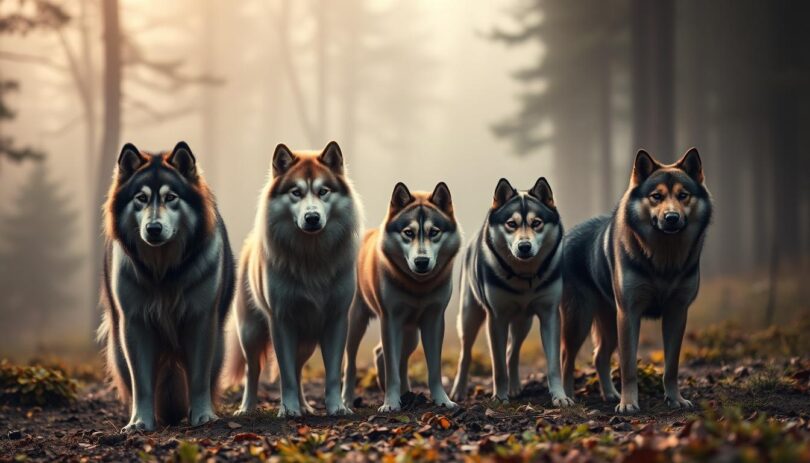Did you know your playful pup shares 99% of its DNA with wild wolves? This genetic overlap explains why many four-legged companions display primal instincts—like howling at sirens or forming tight social hierarchies. Though centuries of domestication have softened their edges, modern breeds still carry ancient traits encoded by their ancestors.
Pop culture has reignited fascination with these rugged characteristics. Shows like Game of Thrones spotlighted majestic, wolf-like appearances, driving demand for breeds with striking resemblance to their wild cousins. But looks only scratch the surface—understanding their behavior requires digging deeper into biology and history.
This article explores how selective breeding shaped today’s canine companions while preserving ancestral quirks. You’ll discover how genetics influence pack mentality, communication styles, and survival instincts. We’ll also debunk myths about “wild” behavior and offer science-backed tips for nurturing these unique pets.
Whether you’re drawn to Siberian Huskies’ piercing eyes or Alaskan Malamutes’ endurance, recognizing their roots creates stronger bonds. Prepare to see your furry friend in a new light—one that bridges the gap between cozy living rooms and untamed wilderness.
Understanding the Wolf-Dog Connection
Modern dogs carry a genetic blueprint nearly identical to their wild ancestors. Research confirms a 99.9% DNA match, with shared genes influencing everything from hunting instincts to social bonding. This deep-rooted connection shapes behaviors still visible in today’s pets.
Genetic Overlap Between Dogs and Wolves
Key genetic markers like the WBSCR17 gene—linked to sociability—show how early canines adapted to human companionship. A 2020 Uppsala University study found this mutation in both ancient wolf remains and modern dog breeds. These shared traits explain why many pups instinctively form packs or communicate through body language.
The Transformation From Wild to Domestic
Early humans likely formed alliances with wolves over 15,000 years ago. Scavenging near settlements, wolves with calmer temperaments thrived. Over generations, selective breeding emphasized these traits, creating proto-dogs suited for guarding and hunting.
Breeders later refined physical and behavioral qualities. For example, northern dog breeds retained thick coats for cold climates while developing cooperative instincts. This careful shaping explains why certain dogs excel at tasks their ancestors mastered millennia ago.
The Evolution of Wolf Like Domestic Dogs
Centuries of human influence have sculpted canine companions into diverse breeds, yet their primal roots remain etched in behavior. While modern varieties vary in size and skill, each carries echoes of ancestral survival strategies refined through generations.
Selective Breeding and Its Impact
Early humans prioritized traits that enhanced cooperation. Herding breeds like Collies were originally bred for quick thinking, while retrievers developed soft mouths for hunting. Over time, preferences shifted toward trainability and sociability—qualities that made dogs ideal family members.
Retention of Wild Instincts Through Time
Despite these changes, intrinsic behaviors endure. Many breeds form structured social hierarchies, mirroring pack dynamics. Siberian Huskies, for example, communicate through vocalizations akin to wild relatives. Such instincts surface during play or when establishing household roles.
Breeders may emphasize physical traits, but nature’s blueprint persists. Understanding this duality helps owners nurture pets while respecting their ingrained needs.
Characteristics of Wolf Like Domestic Dogs
These striking canines captivate with a blend of wild elegance and loyal companionship. Their presence often sparks curiosity, combining primal aesthetics with behaviors shaped by centuries of partnership with humans.
Physical Traits and Coat Features
Thick double coats dominate their appearance, designed for harsh climates. Breeds like the Alaskan Malamute showcase dense undercoats and guard hairs that repel snow. Angular faces, almond-shaped eyes, and erect ears mirror ancestral features seen in historical cave paintings.
Color patterns often echo wilderness camouflage—silver sables, deep grays, and cream blends. These textures aren’t just for show; they require weekly brushing to manage shedding. Owners should prepare for seasonal “coat blows” where tufts float like tumbleweeds!
Behavioral Instincts and Social Dynamics
High intelligence drives their problem-solving skills, but independence can challenge first-time owners. You’ll notice pack-oriented habits: leaning against family members during rest or herding children during play. These social cues reflect ingrained teamwork instincts.
Breeds like the Saarloos Wolfdog thrive on structured routines and mental challenges. Puzzle toys or scent games channel their energy positively. Without proper outlets, boredom may lead to creative—and destructive—solutions.
Understanding these traits builds harmony. Their loyalty shines when respected as thinkers, not just followers. Embrace their quirks, and you’ll gain a companion deeply attuned to your family’s rhythm.
Popular Wolf Like Domestic Dogs Breeds
Certain canines captivate owners through their striking resemblance to wild ancestors. These breeds blend rugged aesthetics with loyal personalities, offering families athletic companions built for adventure.
Northern Powerhouses: Siberian Husky & Alaskan Malamute
The Siberian Husky’s piercing blue eyes and thick coat mirror Arctic survival adaptations. Bred by the Chukchi people for sledding, these dogs thrive in cold climates. Their high stamina makes them ideal for hiking or skijoring.
Alaskan Malamutes showcase strength inherited from freight-pulling ancestors. Weighing up to 100 pounds, they demand vigorous exercise. Both breeds form tight family bonds but retain independent thinking—a nod to their working heritage.
Lesser-Known Gems: Czechoslovakian Vlcak & Finnish Lapphund
Developed in 1955 from German Shepherd and Carpathian Wolf crosses, the Czechoslovakian Vlcak boasts wolf-like agility. These intelligent dogs excel in search-and-rescue roles but require patient training.
The Finnish Lapphund charms with fox-like features and herding instincts. Its double coat protected Sami tribes’ reindeer for centuries. Modern versions remain playful companions, adapting well to active households.
When choosing these breeds, consider their need for mental challenges. Their athleticism and problem-solving skills shine when given purposeful tasks—whether pulling sleds or mastering obstacle courses.
Caring for Your Wolf Like Domestic Dog
Owning a high-energy companion requires more than just love—it demands strategy. These athletic animals thrive when their physical and mental needs align with thoughtful care routines. Balancing structured activities with creative challenges helps channel their natural drive into positive behaviors.
Exercise Needs and Mental Enrichment
Daily exercise isn’t optional—it’s essential. Most breeds need 90+ minutes of vigorous activity like running, hiking, or structured play. Combine physical exertion with brain games: hide treats in puzzle toys or create obstacle courses in your backyard.
Rotate activities weekly to prevent boredom. Try scent work sessions or frozen Kongs stuffed with peanut butter. These outlets satisfy their problem-solving instincts while burning energy. Remember: a tired pet is a happy family member.
Training and Socialization Strategies
Start training early using positive reinforcement. Reward desired behaviors with treats or praise, avoiding punishment-based methods. Focus on commands like “leave it” to manage prey drive during walks.
Socialization builds confidence. Introduce new people, animals, and environments gradually. Enroll in group classes to reinforce obedience skills. Establish clear boundaries at home—consistent rules create security for both pets and families.
For deeper insights into canine behavior, explore these surprising canine facts. Pair structured routines with patience, and you’ll nurture a well-adjusted companion ready for life’s adventures.
How to Identify Wolf Like Domestic Dogs Traits
Spotting ancestral traits in modern canines requires attention to subtle details. While many breeds share physical similarities with wild counterparts, true wolf-like qualities emerge through both appearance and instinctual behaviors.
Recognizing Wolf-Like Appearance
Distinctive features include almond-shaped eyes with amber or ice-blue hues, often appearing more intense than typical breeds. A dense double coat—thick underfur beneath coarse guard hairs—provides weather resistance. Look for erect triangular ears and a straight tail that curves slightly when alert.
Breeds like the Tamaskan or Utonagan showcase these traits prominently. Their color patterns often mimic natural camouflage, blending grays, blacks, and whites. However, coat maintenance demands weekly brushing to manage shedding.
Observing Natural Behavioral Cues
Watch for instinct-driven actions during play or rest. Strong prey drive manifests through chasing squirrels or fixating on moving objects. Vocalizations like howling—rather than frequent barking—signal ancestral communication styles.
Independent problem-solving is common. Your pet might figure out puzzle feeders quickly or test boundaries during training. Early socialization helps channel these instincts positively. Structured routines and interactive games build trust while honoring their heritage.
Remember: even breeds with striking physical similarities adapt well to home life. Focus on providing mental challenges and respecting their need for purposeful activity.
The Genetic Science Behind Wolf Like Domestic Dogs
Genetic blueprints reveal why your canine companion shares ancient survival strategies with their wild relatives. Advanced DNA analysis shows a 99.9% match between modern pets and their ancestors—a connection shaping everything from coat patterns to social instincts.
DNA Similarities and Ancestral Links
Key studies highlight shared genes between Siberian Huskies and Arctic wolves. The ASIP gene controls coat coloration, explaining similar camouflage patterns. German Shepherds inherit heightened olfactory receptors from ancestral lines—traits refined for tracking prey over miles.
Pack-oriented behavior stems from the AVPR1A gene, linked to social bonding. Research shows this marker appears in both wolves and working breeds. These genetic echoes explain why many pets form family hierarchies or guard their homes instinctively.
The Role of Selective Breeding in Behavior
Humans amplified desirable traits over generations. Siberian Huskies retained cold-weather adaptations through controlled pairings. German Shepherds developed problem-solving skills for herding tasks. Breeders prioritized trainability while preserving natural alertness.
Modern science confirms these choices. A 2023 Cornell University study found distinct genetic clusters in working breeds versus companion animals. This intentional shaping explains why some pets excel at jobs their ancestors mastered—from sled-pulling to search missions.
Impact of Media and Pop Culture on Wolf Dog Popularity
When dire wolves prowled TV screens, did viewers realize the real-life impact? Pop culture has reshaped perceptions of athletic breeds, often glamorizing their wild aesthetics while overlooking their complex needs.
The Game of Thrones Effect
After Game of Thrones debuted, Siberian Husky adoptions surged by 300% in some regions. Fans sought pets mirroring the show’s majestic “dire wolves,” unaware these working breeds require hours of daily exercise. Many Alaskan Malamutes and German Shepherds ended up in shelters within a year as overwhelmed owners faced reality.
Public Perception and Ownership Trends
Screen portrayals often confuse people about wolf-like pets’ temperaments. A 2022 RSPCA study found 40% of surrendered huskies were impulse buys influenced by media. Breeders sometimes exploit this demand, prioritizing looks over health—leading to pets with joint issues or anxiety.
Responsible ownership starts with research. These animals thrive with structured training and space to roam. Before adopting, ask: Can your family commit to 90-minute walks daily? Are you prepared for stubborn independence during obedience sessions?
Celebrate their spirit without romanticizing wilderness. With proper planning, these remarkable companions enrich lives—on their terms.
Challenges and Considerations for Owners
What does it take to keep a powerful, athletic pet thriving in a modern home? Owners of these spirited animals face unique hurdles requiring preparation and adaptability. Balancing their primal instincts with domestic life demands thoughtful strategies.
Managing High Energy and Prey Drive
Daily routines must accommodate extraordinary stamina. These working dogs often need 2+ hours of vigorous exercise—think jogging, agility courses, or weighted backpack walks. Without proper outlets, pent-up energy may fuel destructive chewing or escape attempts.
Prey drive poses another challenge. Small animals or moving objects can trigger intense chasing. Trainers recommend “leave it” commands reinforced with high-value treats. Structured play sessions using flirt poles help redirect this instinct safely.
Legal and Practical Aspects
Ownership laws vary widely. Some states require special permits for wolf-like breeds, while others ban them entirely. Always check local ordinances before adopting. Renters often face additional restrictions from landlords or insurance policies.
Secure containment is non-negotiable. Six-foot fences with dig guards prevent escapes driven by curiosity or roaming instincts. Families should puppy-proof homes like toddler zones—these strong pets can open cabinets or knock over furniture during play.
Consulting certified trainers familiar with northern breeds ensures success. Their expertise helps channel natural strengths into positive behaviors, creating harmonious households where both pets and people flourish.
Final Thoughts on Embracing the Wolf Like Domestic Dogs Lifestyle
Embracing breeds with ancestral roots means celebrating their rich history while meeting modern needs. These animals carry genetic legacies that shape their stamina, intelligence, and social bonds. By understanding their lineage, families create environments where natural instincts thrive alongside home life.
Choosing breeds like the Canadian Eskimo Dog or German Shepherd requires research. Their stamina and drive demand purposeful activities—sled sports, advanced training, or interactive play. Early socialization helps them adapt to people and strangers, turning challenges into rewarding partnerships.
Successful ownership balances respect for their wild-inspired traits with consistent care. Structured routines, mental enrichment, and patience foster trust. Though high-energy companions need commitment, their loyalty and unique personalities bring endless joy to families.
Remember: these remarkable pets bridge wilderness and warmth. With thoughtful preparation, their spirited nature becomes a source of connection—a daily reminder of life’s wild beauty thriving in your living room.
FAQ
What makes breeds like the Siberian Husky resemble their wild ancestors?
Northern breeds retain physical and behavioral traits through selective breeding. Thick double coats, upright ears, and high stamina reflect adaptations to harsh climates. Their pack mentality and vocal communication also mirror ancestral social structures.
Are wolf-like breeds suitable for first-time owners?
Breeds such as the Alaskan Malamute or Canadian Eskimo Dog require experienced handling due to strong independence and energy levels. Consistent training, early socialization, and ample exercise are crucial for harmonious living.
How much daily activity do these dogs need?
High-energy working dogs thrive with 1–2 hours of vigorous exercise. Activities like jogging, sled-pulling, or agility training prevent boredom and channel their natural drive. Mental enrichment through puzzle toys complements physical exertion.










Leave a Comment